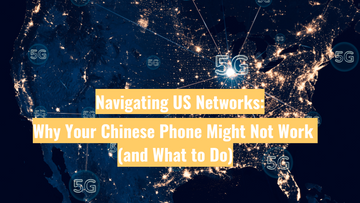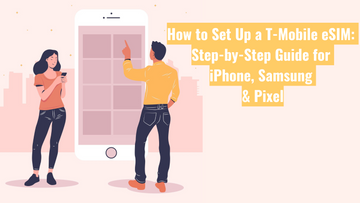Navigating US Networks: Why Your Chinese Phone Might Not Work (and What to Do)

Planning a trip to the United States? One of the last things you want is to land in New York, Los Angeles, or the Grand Canyon—only to find your phone doesn’t work properly.
If you’re using a Chinese-brand phone (like Huawei, Xiaomi, Oppo, or Vivo), you might run into network compatibility issues, especially with US mobile carriers like AT&T and T-Mobile.
In this guide, we’ll break down why that happens and what you can do to stay connected without hassle.
The US Mobile Landscape: AT&T and T-Mobile
The two biggest GSM-based carriers in the US are:
- AT&T
- T-Mobile
These networks are the primary options for travellers using international travel SIMs or eSIMs, since they’re compatible with most unlocked phones.
There’s also Verizon, which historically used CDMA and still has quirks with certain devices—so it’s not our focus here.
Understanding Frequency Bands
Think of mobile frequency bands like radio stations. Just like your radio can only tune into specific frequencies, your phone can only connect to mobile bands it was designed to support.
If your phone doesn’t “speak the same language” as the network (i.e., support the same bands), it won’t work properly—or at all.
Why Chinese Phones Often Struggle in the US
Phones sold in mainland China or made by Chinese brands are typically built for:
- Chinese mobile networks
- Asian and European frequency bands
The US uses different frequency bands, especially for low-band and mid-band LTE and 5G, which are crucial for signal strength, coverage, and speed.
So even if your phone supports 4G or 5G back home, it might not support the right bands for full coverage in the United States.
Critical Frequency Bands in the US
T-Mobile
- Band 71 (600 MHz): Extended Range LTE & 5G – vital for rural areas and better indoor signal
- Bands 2, 4/66 (1900 MHz and 1700/2100 MHz): Core 4G LTE
- Band 41 (2500 MHz): Ultra Capacity 5G – fast and widely deployed
AT&T
- Bands 12/17 (700 MHz): Long-range LTE coverage
- Band 14 (700 MHz): Used for FirstNet (emergency services) but also available to consumers
- Bands 2, 4/66, 5: Found in many urban areas
The “Missing Bands” Problem
Here’s what happens when your phone doesn’t support these bands:
- No signal or very weak service in rural or suburban areas
- Slower speeds, even in cities
- No VoLTE (Voice over LTE) – increasingly required since older 2G/3G networks are being shut down
- No usable 5G, even if your phone is technically 5G capable
Some travellers report that their phones work in downtown Los Angeles or New York, but as soon as they leave the city—no signal.
How to Check If Your Phone Will Work in the US
1. Use an IMEI Checker
Use official carrier tools:
Or try third-party tools like FrequencyCheck.com.
2. Look Up Your Phone’s Specs
Find your exact model number (usually in your settings or on the box), then look up its supported frequency bands on the manufacturer’s website or a reputable tech site. Compare these bands to the ones used by AT&T and T-Mobile.
What If Your Phone Isn’t Compatible?
Here are your options:
- Buy or rent a phone that’s compatible with US networks
- Use Wi-Fi only with VoIP apps like WhatsApp, Viber, and Messenger to stay connected
- Get a travel SIM from us and pair it with a compatible device for seamless coverage across the US
At Global Starlink, we offer prepaid US travel SIMs and eSIMs that work perfectly on AT&T and T-Mobile’s networks—as long as your device is compatible.
Conclusion: Travel Smart, Stay Connected
When travelling to the US, phone compatibility can make or break your experience. Chinese phone brands often miss key US frequency bands, causing dropped calls, no data, and limited or no 5G—even with a good travel SIM.
- Check your phone's bands before you fly
- Use a reliable travel SIM or eSIM
- Consider a compatible phone if needed
Browse our range of USA Travel SIMs and eSIMs designed to give you reliable coverage, high-speed data, and peace of mind while travelling across the United States.












